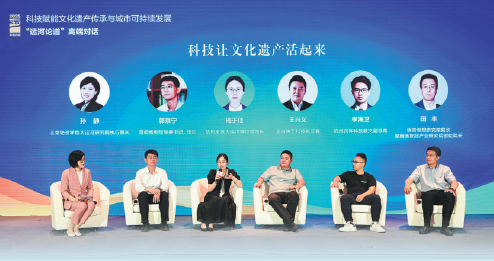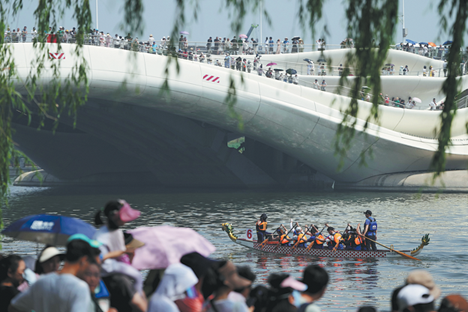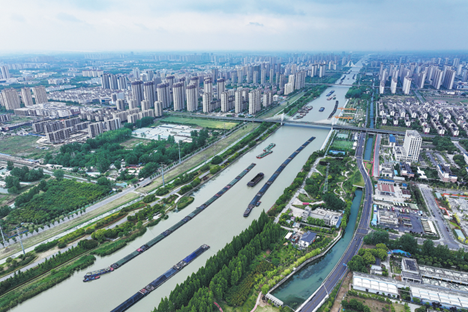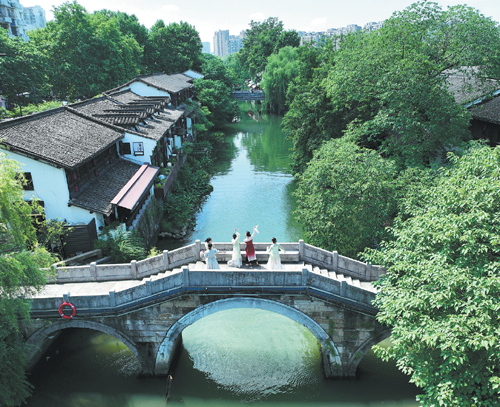How tech bridges Grand Canal culture
Innovations like AI are transforming preservation and heritage along China's most celebrated man-made waterway and beyond, Yang Yang reports.

Digital technology is transforming cultural experiences like museum trips at unprecedented speeds. Visitors can use DeepSeek to create plans and AI can generate and edit personalized vlogs afterward — and much more.
Tech's role in cultural heritage preservation featured at the high-level Canal Dialogue convened in Beijing on May 30 as part of the 2025 China Grand Canal Cultural Belt Beijing-Hangzhou Dialogue.
The Grand Canal has enabled cities to flourish for centuries. Today, technologies are advancing new models of sustainable urban development along the south-to-north waterway.
For instance, the Beijing (Tongzhou) Grand Canal Cultural Tourism Scenic Area, a national 5A site, employs digital display spaces and smart garden management to make the canal's history and culture more accessible and engaging, says Hou Jianmei, a senior official of Tongzhou district.
Furthermore, Tongzhou is also pioneering the development of smart scenic areas, employing light-and-shadow storytelling, advancing audio-visual experiences and fostering cultural creativity to enhance the preservation and use of the Grand Canal's cultural legacy, Hou adds.
Similarly, in Hangzhou's Gongshu district in Zhejiang's provincial capital, the revamped Beijing-Hangzhou Grand Canal Museum experienced a surge in visitor numbers to over 1.2 million in 2024, a 73 percent increase over the previous year. Additionally, nearly 100 "technology and culture" events across the district attracted over a million attendees.
These figures underscore how technology is directly enhancing cultural and tourism development, says Ying Qiaohua, a senior official of Gongshu.
As digitalization progresses, the ancient culture of the Grand Canal is entering a new era of digital intelligence. With the aid of cutting-edge technology, the dissemination of canal culture has transcended time and space, resulting in a rich array of content and mediums.
During a roundtable discussion, representatives from museums and tech companies discussed how technology revitalizes cultural heritage.
Capital Museum director Guo Jingning says technological empowerment and innovation have been central to the Grand Canal Museum of Beijing's mission from its inception.
The museum extensively employs technology to research, preserve and showcase artifacts, he says.
"We use multidisciplinary research and various application scenarios to narrate the canal's story, achieving a balance where content is the core, technology is the enabler, and dissemination is the pathway. This approach allows us to use technology to protect the past, shape the present and envision the future," he says.
Yang Yujia, director of the Beijing-Hangzhou Grand Canal Museum, says that while the current "museum craze" helps spread the canal's stories, infusing museums with technology should not be about pursuing flashy effects or mere visual impact. It should involve the deep integration of technology in areas like artifact preservation, exhibitions, public services and education, she explains.
Wang Xingyi, vice-president of Kuaishou Technology, highlights the popularity of intangible cultural heritage on the Kuaishou streaming platform, where over 11 million craftspeople actively share their heritage, and leveraging new technology can also significantly aid in disseminating the Grand Canal culture.
For example, Kuaishou's Keling AI can enhance video creation tools and formats, empowering users to re-create and share historical culture and stories, he explains.
Ji Haiwei, vice-president of Hangzhou Lingban Technology, says that the company's augmented reality guide glasses are now used in over 300 museums and tourist sites across China, including several city museums along the Grand Canal.
By deeply integrating AR (augmented reality) and AI technologies, the culture of the Grand Canal is liberated from the constraints of time and space, presenting itself in an immersive, interactive and global manner. This redefines the modern value of cultural heritage, he says.
Ji also emphasizes that tech companies should employ natural and simple interactive designs to quickly connect audiences with culture, allowing historical culture to seamlessly enter the audience's minds and resonate with them.
However, Yang warns that as museums evolve, they must remain true to their cultural roots, using technology as a tool to present culture in innovative ways, which represents both a trend and a challenge for museum development.
Looking ahead, Tian Feng, head of an institute called Kuaisimanxiang, that translates as thinking fast and slow, engaging in research, consulting and training in the fields of AI and robotics, highlights the emergence of tourism-focused intelligent systems.
Using AI and other intelligent systems, these platforms can recommend museums and attractions, seamlessly integrating travel, dining and accommodation to enhance tourism, he says.
Technologies such as AI, extended reality, 3D printing and panoramic cameras can infuse new commercial vitality into the Grand Canal experience, Tian explains, emphasizing the importance of creating interactive digital products that can sustain visitors' interest.
Sun Jing, executive director of the Grand Canal Research Institute of Beijing Wuzi University, says AI will deepen the integration of culture and tourism, producing new consumption modes.
This includes using large language models to connect such elements as guides, information and shopping, generating AI-rendered avatars of historical figures to interact with visitors and transforming online and offline tours, she says.
"These multidimensional scenarios are poised to unlock new consumption potential," she adds.






Today's Top News
- Israel launches attack on Iran's nuclear sites
- Israel conducts preemptive strike on Iran, says defense minister
- The bumpy road of international trade
- China, Africa pledge to strengthen trade ties
- Li: Bolster Sino-EU cooperation
- Carmakers vow to ensure timely payments for suppliers






























